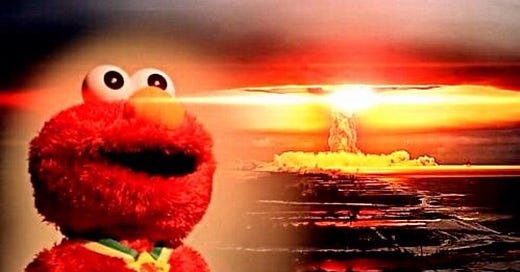I’ve been making my way through the writer Dorian Lynskey’s recent and absorbing study Everything Must Go: The Stories We Tell About the End of the World, and it got me thinking about my favorite books, movies, and music that dwell on the end of the world as we know it in some way, shape, or form. Lynskey takes readers on a tour of apocalyptic narratives from the Book of Revelation and Romantic writers like Byron and Shelley to the seemingly endless supply of modern stories about asteroid strikes, nuclear war, pandemics, and artificial intelligence run amok.
The excellent streaming series Paradise represents just the most recent entry in this constantly-expanding and occasionally thoughtful genre. Beyond Paradise, here are a few of the stories and songs about the end of the world that have stayed with me over the years.
The Last Days of the Dinosaurs: It’s non-fiction, but paleontologist Riley Black’s portrait of the demise of the dinosaurs certainly reads like an end-of-the-world thriller. The Chicxulub asteroid impact, she writes, was “the single worst day the planet ever experienced”—and that’s something of an understatement. She describes the immediate consequences of the impact in what’s now the Yucután Peninsula in vivid detail and shows how life on Earth—including our mammalian ancestors—managed to survive the worst cataclysm it faced, if only just barely. A searing global heat pulse, raining molten debris, worldwide fires, acid rain and ocean acidification, and a lengthy impact winter that nearly brought photosynthesis to an end killed off the dinosaurs and much else besides in one fell swoop.
A Canticle for Leibowitz: Author Walter M. Miller, Jr.’s three-part 1959 tale of humanity’s eventual emergence from a post-nuclear war dark age, shepherded by knowledge-preserving monks from the Catholic Church’s Albertine Order of Saint Leibowitz, remains striking in its depiction of the world struggling to recover from the “Flame Deluge” and intent on making the same mistakes all over again. It’s a novel that, among other things, contrasts individual and collective human resilience with the equally resilient human drive toward self-destruction and inability to learn from past errors. Humanity survives the worst catastrophe imaginable and bounces back (even if it takes a millennium), only to recreate the circumstances that led to its ruin in the first place. The book obviously reflects the anxieties of the early nuclear age, but its unique narrative conceit and ambivalence about human nature make it well worth the read.
On the Beach: Another artifact of the early Cold War, this 1957 novel by author and aeronautical engineer Nevil Shute—his works included the British airship R100—takes place after a nuclear war involving cobalt-jacketed bombs has created a cloud of lethal radiation that slowly but relentlessly descends on the last untouched part of the globe: Australia. The main action involves an American submarine crew and its search for a radio signal presumably sent by other survivors, only for that slim optimism to be dashed. Despite its fundamental hopelessness, the book doesn’t succumb to nihilism: Shute’s characters face the prospect of their inevitable demise with quiet dignity, doing their duty as they see it and enjoying what time they have left.
“1999,” “America,” and “Sign O’ The Times”: Oddly enough, Lynskey’s book contains just one off-hand reference to Prince despite the artist’s fertile if neurotic preoccupation with nuclear war at the height of his creative powers in the 1980s. The title track to the album 1999 dwells extensively on the prospect of an imminent world-ending nuclear holocaust, for instance, while “America” from Around the World in a Day ends with a nuclear exchange punctuated by repeated and aggressive invocations of “booms.” Meanwhile, the title track from 1987’s Sign O’ The Times references both Christian eschatology and President Ronald Reagan’s anti-ballistic missile Strategic Defense Initiative, aka “Star Wars.” Indeed, Prince infuses all three songs with his own strong, personal streak of apocalyptic Christianity—traces of which can be found throughout his music across the decades.
Planet of the Apes: Even if you haven’t seen this classic 1968 science-fiction film, you probably have picked up the plot by osmosis: a misanthropic astronaut played by Charlton Heston finds himself marooned on a planet run by intelligent simians, only to discover that he’s been back on Earth the whole time. After we see Heston pounding his fist into the sand and damning to hell all the maniacs who “finally really did it,” the camera pulls back to reveal a rotting Statue of Liberty poking sideways out of the beach before cutting to black. It’s a scene that’s been referenced and parodied a thousand different ways over the decades (especially by The Simpsons) but still retains its power—even when you know it’s coming.
But wait, there’s more! Here are a few more post-apocalyptic media entries that are worth checking out.
The Postman, science-fiction novelist David Brin’s compelling 1985 riposte to all-too-common survivalist fantasies and anti-government delusions—spoiler alert: the survivalists cause the end of the world.
The Rise and Fall of Ziggy Stardust and the Spiders from Mars, David Bowie’s 1972 quasi-concept album about an androgynous, bisexual alien who tries to save the Earth from a five-year death sentence through the power of rock n’ roll.
No list of apocalyptic media would be complete without the inclusion of R.E.M.’s stream-of-consciousness track “It’s the End of the World as We Know It (And I Feel Fine)” from the band’s 1987 album Document.
Children of Men, director Alfonso Cuarón’s uncanny portrayal of a decaying, infertile near-future society with a glimmer of hope in the form of the first child born in decades.
Perhaps the ur-text for modern fears of a machine apocalypse, James Cameron’s original 1984 thriller The Terminator remains the best of the entire time-traveling robot-assassin franchise—a hair above the sequel Terminator 2: Judgment Day.



